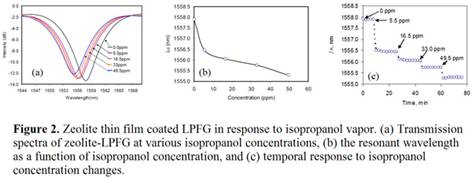

43927-GB5
Investigation of adsorption-dependent optical refractive index of microporous MFI zeolite thin films for the development of in situ chemical sensors
Introduction: Low-cost optical chemical sensors capable of fast and in situ detection of various organic compounds are highly demanded in petroleum industry. Unfortunately, currently available sensors are insufficient in sensitivity, specificity and stability to measure the large number of organic compounds involved in petroleum production, transportation, storage and post processing. Integration of chemical recognition materials with optical microdevices has become an effective approach for chemical sensor development. Our recent work reveals that nanoporous zeolites process the unique combination of chemical and optical properties that are idea for development of highly sensitive and selective chemical sensors. We have successfully developed a new type of chemical sensor by directly synthesizing zeolite thin films on optical fibers, and demonstrated their capability for sensitive detection of various organics in gas and liquid phases. However, further improvement of the sensor performance requires an in-depth understanding of the optical behavior of zeolites upon interaction with various chemicals.
Objective: In this project, we aim to conduct the fundamental research of characterizing the adsorption-dependent optical refractive index of various zeolite thin films for the purposes of chemical sensor development and optimization. The data obtained from this proposed research will enhance our basic understandings of the optical properties of zeolite materials. In addition, the data are fundamentally important to the fields of materials science, photonics, and chemical engineering and useful for theoretical modeling in material chemistry and device physics.
Major Research Results: The research of the first project year was concentrated on study the chemical adsorption induced optical property changes in Zeolite crystals and thin films. With the adsorption induced refractive index known, we focused on the integration of zeolite thin films with various microphotonic devices to develop and demonstrate novel chemical sensors for highly sensitive chemical detection. Two microphotonic devices have been developed for this purpose, including the long period fiber grating (LPFG) and the core-cladding mode interferometer (CCMI).
A LPFG is an in-line fiber device that can
thus be used as a refractometer with very high
sensitivity. As shown in Figure 1, the sensor was made by coating a thin layer
of zeolite film on a LPFG. Upon adsorbing analyte
molecules, the zeolite thin film changes its refractive index, producing a
shift of the grating resonance wavelength ( The zeolite coated LPFG sensor was tested for
detection of isopropanol vapors. The results of isopropanol vapor detection
were shown in Figure 2. The sensor responded very sensitively to isopropanol
vapor. The estimated detection sensitivity was about 4ppb (parts-per-billion).
The sensor also responded to isopropanol quickly.
The zeolite coated LPFG sensor was also
tested for detection of toluene vapor. The results were shown in Figure 3. The
sensor responded very sensitively to toluene vapor. The estimated detection
limit was about 300ppt (parts-per-trillium).
Conclusions and
Future Work: In the reported period, we successfully integrated MFI zeolite
materials with long period fiber gratings to develop highly sensitive chemical
sensors. The test results indicated that the integration effectively harvests
the chemical properties of microporous zeolites for chemical detection. In the next performance
period, we will focus our research on studying the adsorption preference of microporous zeolite towards different chemicals for the
purpose of improving the selectivity of the sensors.


